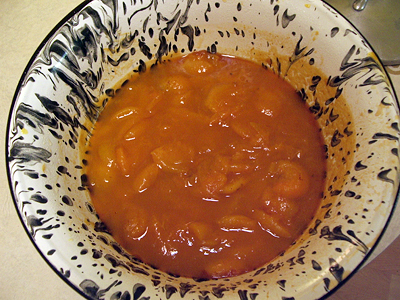Underappreciated fruits and vegetables will always have a special place in my heart. Rhubarb, nettles, quince: all these things, so tasty when cooked, used to be very popular until they got shouldered aside by easier pleasures that didn't sting the unwary picker into welts, or weren't so sour or astringent at first bite as to make you wince. Artichokes' dip-scooping leaves were probably its saving grace. But for its use as a nifty delivery system for melted butter and lemon mayonnaise, it would be a forgotten thistle today.
Apricots, while more accessible, still have a certain forgotten-fruit quality to them. Just as quince gets described as apple's tough, weird older sister, so apricots are often just a placeholder for peach-lovers, something sweet and orange with a pit that will do until the real goodies come along.
But apricots are good for cooking in a way that peaches aren't, their flavor intensifying into an ineffable tangy sweetness that leans just right against a crumbly, buttery short crust or a piece of whole-grain toast, especially one spread with mild fresh chevre. Too often, though, all that the marketplace offers is the big bland Patterson, so smooth-skinned, so bright, so uniform and so utterly dull.
What you really want, especially for jam, are Blenheims, also called Royal Blenheims. You have to trust in these, because they're not so pretty. Mostly they're small, often green-shouldered, often freckly. At peak ripeness, they're almost deliquescent, their pulp turning to jam right inside the skin.
But, oh, what juicy, sticky-dripping flavor! Slurpy-good right off the tree, they're sublime for jam. I like to use the same overnight-sugar macerating technique as for strawberries, although these apricots don't throw off enough liquid to make straining necessary. Instead, they subside gracefully into a pool of satiny slush that's part pulp, part skin, part juice, and all divine.
